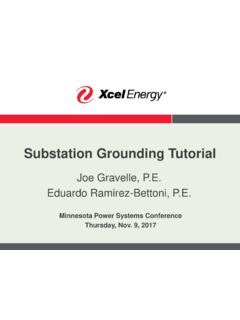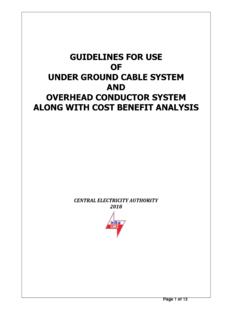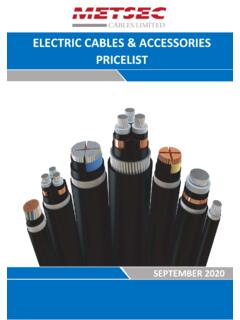Transcription of Transmission Lines and Power Flow Analysis
1 School of Engineering (SOE). University of St Thomas (UST). Transmission Lines and Power Flow Analysis Dr. Greg Mowry Annie Sebastian Marian Mohamed 1. School of Engineering The UST Mission Inspired by Catholic intellectual tradition, the University of St. Thomas educates students to be morally responsible leaders who think critically, act wisely, and work skillfully to advance the common good. Since civilization depends on Power , Power is for the common good'!! 2. School of Engineering Outline I. Background material II. Transmission Lines (TLs). III. Power Flow Analysis (PFA). 3. School of Engineering I. Background Material 4. School of Engineering Networks & Power Systems In a network ( Power system) there are 6 basic electrical quantities of interest: 1. Current = / . 2. Voltage = / (FL).. 3. Power = = =.. 5. School of Engineering Networks & Power Systems 6 basic electrical quantities continued.
2 4. Energy (work) w t = . = .. 5. Charge (q or Q) = .. 6. Flux = .. 6. School of Engineering Networks & Power Systems A few comments: Voltage (potential) has potential-energy characteristics and therefore needs a reference to be meaningful; ground 0 volts I will assume that pretty much everything we discuss & analyze today is linear until we get to PFA. 7. School of Engineering Networks & Power Systems Linear Time Invariant (LTI) systems: Linearity: If 1 = 1 & 2 = ( 2 ). Then 1 + 2 = ( 1 + 2 ). 8. School of Engineering Networks & Power Systems Implications of LTI systems: Scalability: if = ( ), then = ( ). Superposition & scalability of inputs holds Frequency invariance: = . 9. School of Engineering Networks & Power Systems ACSS and LTI systems: Suppose: = cos + . Since input = output, the only thing a linear system can do to an input is: Change the input amplitude: Vin Vout Change the input phase: in out 10.
3 School of Engineering Networks & Power Systems ACSS and LTI systems: These LTI characteristics along with Euler's theorem = cos + sin , allow = cos + to be represented as = cos + = . 11. School of Engineering Networks & Power Systems In honor of Star Trek, = . is called a Phasor'.. 12. School of Engineering = 13. School of Engineering Networks & Power Systems ACSS and LTI systems: Since time does not explicitly appear in a phasor, an LTI system in ACSS can be treated like a DC system on steroids with j ACSS also requires impedances; AC resistance 14. School of Engineering Networks & Power Systems Comments: Little, if anything, in ACSS Analysis is gained by thinking of j = 1 (that is algebra talk). Rather, since Euler Theorem looks similar to a 2D. vector = cos + sin . = + 15. School of Engineering 90 = cos 90 + sin 90 = . Hence in ACSS Analysis , think of j as a 90 rotation 16.
4 School of Engineering Operators v(t ) V V . dv dt j V. V. vdt j . 17. School of Engineering Ohm's Approximation (Law). Summary of voltage-current relationship Element Time domain Frequency domain R. v Ri V RI. L v L. di V j LI. dt C dv V . I. i C. dt j C. 18. School of Engineering Impedance & Admittance Impedances and admittances of passive elements Element Impedance Admittance R 1. Z R Y . R. L 1. Z j L Y . j L. C 1. Z Y j C. j C. 18. School of Engineering The Impedance Triangle 18. Z=R+jX. School of Engineering The Power Triangle (ind. reactance). 18. S=P+jQ. School of Engineering Triangles Comments: Power Triangle = Impedance Triangle The cos( ) defines the Power Factor (pf). 22. School of Engineering Reminder of Useful Network Theorems KVL Energy conservation = 0. KCL Charge conservation = 0. Ohm's Approximation (Law). Passive sign Convention (PSC). 23. School of Engineering Passive Sign Convection Power System 24.
5 School of Engineering PSC Source Load or Circuit Element PSource = vi PLoad = vi 25. PSource = PLoad School of Engineering Reminder of Useful Network Theorems Pointing Theorem = . Thevenin Equivalent Any linear circuit may be represented by a voltage source and series Thevenin impedance Norton Equivalent Any linear circuit my be represented by a current source and a shunt Thevenin impedance 26. = . School of Engineering (SOE). University of St Thomas (UST). Transmission Lines and Power Flow Analysis Dr. Greg Mowry Annie Sebastian Marian Mohamed 1. School of Engineering II. Transmission Lines 2. School of Engineering Outline General Aspects of TLs TL Parameters: R, L, C, G. 2-Port Analysis (a brief interlude). Maxwell's Equations & the Telegraph equations Solutions to the TL wave equations 3. School of Engineering 4. School of Engineering 5. School of Engineering Transmission Lines (TLs).
6 A TL is a major component of an electrical Power system. The function of a TL is to transport Power from sources to loads with minimal loss. 6. School of Engineering Transmission Lines In an AC Power system, a TL will operate at some frequency f; 60 Hz. Consequently, = / . The characteristics of a TL manifest themselves when ~ of the system. 7. School of Engineering USA example The USA is ~ 2700 mi. wide & 1600 mi. from north-to-south ( x m). 3 8. For 60 Hz, = = 5 6 . 60. Thus ~ and consequently the continental USA Transmission system will exhibit TL characteristics 8. School of Engineering Overhead TL Components 9. School of Engineering Overhead ACSR TL Cables 10. School of Engineering Some Types of Overhead ACSR TL Cables 11. School of Engineering TL Parameters 12. School of Engineering Model of an Infinitesimal TL Section 13. School of Engineering General TL Parameters a.
7 Series Resistance accounts for Ohmic (I2R losses). b. Series Impedance accounts for series voltage drops Resistive Inductive reactance c. Shunt Capacitance accounts for Line-Charging Currents d. Shunt Conductance accounts for V2G losses due to leakage currents between conductors or between conductors and 14. ground. School of Engineering Power TL Parameters Series Resistance: related to the physical structure of the TL conductor over some temperature range. Series Inductance & Shunt Capacitance: produced by magnetic and electric fields around the conductor and affected by their geometrical arrangement. Shunt Conductance: typically very small so 15. neglected. School of Engineering TL Design Considerations Design Considerations Responsibilities 1. Dictates the size, type and number of bundle conductors per phase. 2. Responsible for number of insulator discs, vertical or v-shaped arrangement, Electrical Factors phase to phase clearance and phase to tower clearance to be used 3.
8 Number, Type and location of shield wires to intercept lightning strokes. 4. conductor Spacing's, Types and sizes Mechanical Factors Focuses on Strength of the conductors, insulator strings and support structures Environmental Factors Include Land usage, and visual impact Economic Factors Technical Design criteria at lowest overall cost 16. School of Engineering Transmission Line Components Components Made of Types ACSR - Aluminum conductor Steel Reinforced AAC - All Aluminum conductor AAAC - All Aluminum Alloy conductor ACAR - Aluminum conductor Alloy Reinforced Aluminum replaced Conductors Alumoweld - Aluminum clad Steel conductor copper ACSS - Aluminum conductor Steel Supported GTZTACSR - Gap-Type ZT Aluminum conductor ACFR - Aluminum conductor Carbon Reinforced ACCR - Aluminum conductor Composite Reinforced Pin Type Insulator Porcelain, Toughened Insulators Suspension Type Insulator glass and polymer Strain Type Insulator Steel, Alumoweld Shield wires Smaller Cross section compared to 3 phase conductors and ACSR.
9 Wooden Poles Lattice steel Tower, Reinforced Concrete Poles Support Structures Wood Frame Steel Poles Lattice Steel towers. 17. School of Engineering ACSR conductor Characteristic Overall Dia DC Resistance Current Capacity Name (mm) (ohms/km) (Amp) 75 C. Mole 70. Squirrel 107. Weasel 138. Rabbit 190. Racoon 244. Dog 291. Wolf 405. Lynx 445. Panther 21 487. Zebra 737. Dear 756. Moose 836. Bersimis 998 18. School of Engineering TL Parameters - Resistance 19. School of Engineering TL conductor resistance depends on factors such as: conductor geometry The frequency of the AC current conductor proximity to other current-carrying conductors Temperature 20. School of Engineering Resistance . The DC resistance of a conductor at a temperature T is given by: ( ) = .. where T = conductor resistivity at temperature T. l = the length of the conductor A = the current-carry cross-sectional area of the conductor .
10 The AC resistance of a conductor is given by: =.. where Ploss real Power dissipated in the conductor in watts I rms conductor current 21. School of Engineering TL conductor Resistance depends on: Spiraling: The purpose of introducing a steel core inside the stranded aluminum conductors is to obtain a high strength-to-weight ratio. A. stranded conductor offers more flexibility and easier to manufacture than a solid large conductor . However, the total resistance is increased because the outside strands are larger than the inside strands on account of the spiraling. 22. School of Engineering The layer resistance-per-length of each spirally wound conductor depends on its total length as follows: . = + ( ) /m . where - resistance of the wound conductor ( ). 1. 1 + ( )2 - Length of the wound conductor (m).. p = - relative pitch of the wound conductor (m). 2 . - length of one turn of the spiral (m).







